How big is a session?
All FAQ Questions – A session can be as big as a 15,000 graft transplant procedure. This can be done over a series of back to back work days. Depending on your hair characteristics 800-1500 BHT or UGraft – FUE grafts can be transplanted in a single day.
Is it painful?
The entire procedure is done under local anesthesia with the patient awake and often watching a movie. Pain is minimal both during and after this minimally invasive procedure. Typically, a mild oral sedative is given before the procedure. Most patients do not require a pain killer after the procedure. Read more about pain control here.
Where is the procedure performed?
It is performed in the procedure room of the Redondo Beach office of Dr Umar in a most relaxing atmosphere.

Are female patients good candidates for UGraft using head or body hair (BHT)?
Female patients often would require investigation for other treatable causes of hair loss. This requires the input of a skin and hair specialist (a dermatologist). Dr. Umar is board certified by the American Board of Dermatology, and is qualified to manage female patients with complaints of hair loss. Dr. Umar often receives referral of female patients from other physicians including other hair transplant doctors who are not certified dermatologists. Dr. Umar may require performing some tests to determine the cause of your hair loss and the best treatment options available. Once determined to be good candidates for UGraft hair transplant the process is done with special considerations for cutting less donor hair. Read more about women and UGraft hair restoration methods here.
What qualities make FUE far more superior than the traditional strip surgery?
Traditional hair transplantation requires the cutting of a slice of flesh from the back and side of the head. The result is a linear scar that can potentially widen overtime. The patient is forever forced into a lifelong self conscious struggle to hide the scar. FUE-UGraft is linear scar free and minimally invasive. Patients without linear scars have the option of cutting their hair as short in ways never before possible with traditional strip hair transplant which is also called Follicular Unit Transplantation – FUT and follicular unti hair transplantation -FUHT or Follicular Unit Strip Surgery – FUSS. The patients are not left self conscious about a linear scar that could get exposed in windy situations or when swimming or even when the spouse runs their hands through the hair.

Is FUE or strip surgery better for hair transplantation?
If you anticipate the need to keep an overall shorter hair style, then you want to avoid the traditional hair transplant linear scar that would necessarily result from Follicular Unit Strip Surgery (FUSS), It would make sense to do Follicular Unit Extraction (FUE) instead. If you already have a strip scar from prior surgery or never anticipate keeping a short hair cut, then FUSS could be considered. I am of the opinion that FUSS is perhaps too invasive a method for procedures involving less than 500 grafts.
How long does it take for the hair transplant to heal after BHT?
Dr U performs hair transplantation using very tiny devices to prepare the recipient areas with slits into which the donor hair units are implanted. These tiny slits are created in the most minimally traumatic manner that makes the healing course rapid after the hair transplant. Because of the microsurgical technique used by Dr. Umar and his unique approach of hair transplantation of using body hair (BHT) extractions, the hair transplant will ensure the smallest wounding process, and healing for patients has been very remarkable. Patients are often able resume their daily lives and most normal activities the very next day. The time for which the signs of surgery are completely gone has ranged from 3 weeks to 4 months on the average. Read more about wound healing post body hair transplantation here.
What is the most important aspect of the whole transplantation process?
Finding the right hair surgeon to perform your hair transplantation is the most important decision for the whole process. Having your hair transplant done by an unethical or inexperienced hair surgeon can lead to more turmoil in the future then helping you improve your life. Dr. Umar believes against the sales behavior that reflects many strip surgery clinics. He believes in the integrity of the FUE procedure, and that is why Dr. Umar chooses to specialize in FUE due to its minimally invasive and scalpel free requirements. This provides the patient with less pain, more natural results, and most especially, a linear scar free donor area. Dr. Umar is a pioneer in the practice of FUE and has even taken the step to advance the procedure into one of his own, which he calls the UGraft. UGraft advanced FUE allows for the usage of body hair (BHT) for hair transplant, which gives hope to many patients who have a limited number or no donor hair at all to have the hair transplant that they finally desired for.
What are the characteristics of pattern baldness?
The typical characteristics of male pattern baldness begin with the receding of the hairline which eventually leads to bald spots on the top of the head. Male pattern baldness also tend to affect men whose hair follicles possess a higher sensitivity to normal levels of testosterone. This testosterone which converts to the hormone dihydrotestosterone (DHT) will trigger the interaction with hair follicles that are vulnerable to the affects of DHT, causing hair to fall out. Women can also experience hair loss due to heredity and age, but they will experience it more especially after menopause and stress. The pattern of female hair loss is different from that of men because women usually have hair loss occurring throughout their scalp while the front remains decently covered and intact.
Is it beneficial to use Propecia after a hair transplant?
Even though Propecia has no effect on transplanted hair after a hair transplant, it can assist to maintain the patient’s surrounding hair and is therefore useful as an appendage to head hair transplant surgery, and thus will enable the patient to obtain a better overall result. According to top hair transplant surgeon Dr. Umar, patients undergoing body hair transplantation should use Propecia with caution and consult before usage with an experienced hair transplantation surgeon. For patients using body hair transplantation, Dr Umar has advised that propecia and other 5AR medications may have a negative effect on their BHT results. For more on this click: The role of 5 alpha reductase inhibitors on Body Hair Transplantation
How are eyebrow hair transplants different from typical head hair transplants?
Eyebrow transplants are different from hair transplants for a variety of reasons, with the most significant difference being that eyebrow hairs grow from the hair follicle at very acute angles. This angle is what gives eyebrows the flat appearance on the eyebrow ridge, which in contrast, scalp hair rises at a 45 or more angle from the scalp. In addition, the growth cycle of eyebrows hairs is much shorter than the growth cycle of head hair, with a phase of growth in approximately 4 months as compared to the 3 to 7 year anagen phase of head hair. Eyebrow hairs also grow dramatically in different directions in all sections of the eyebrow. The hairs also grow as individual strands only, meaning they do not grow in groups called follicular units. Using either body or head hair follicles derived by the UGraft Hair Transplants, these hair follicles can be transplanted to reconstruct the eyebrows. Unlike hair transplants, where the donor hair is extracted from the scalp or body and thus grows in similarity to original head hair, the donor hair for eyebrow transplants taken from a different area of the body will be different in the aspects of growth rate and appearance. In addition, another difference with using head or body hair for eyebrow transplants is that the hair will continue to grow, which requires for the frequent trimming of the hairs in order to maintain an acceptable and physically appealing eyebrow appearance.

Why does hair loss occur?
The reason for hair loss resides in the genetic predisposition of the hair follicle itself, rather than that of the scalp. Therefore, transplanted hairs will continue growing because the hair follicle keeps its original genetic coding, and thus these are the follicles that are not affected by Dihydrotestosterone (DHT), which is the hormone that causes male-patterned baldness. In addition, despite being moved into a formerly bald area, it still maintains its donor hair characteristics, which is to not fall out and keep regrowing hair. When DHT resistant hair from the back of the scalp is transplanted to the top, it will continue to be resistant to DHT in its new location and grow normally. Immediately after the follicular unit hair grafts are extracted and transplanted into the scalp, the surrounding tissue will begin feeding the transplanted follicle and the healing process begins. The hair shaft may also shed, but the hair follicles will stay and often go into telogen (resting) phase. It is surveyed that hair graft survival rates are nearly 100%, although about 85-90% would manifest above the skin at any given time due to cycling.
Is it a good idea to have a hair transplant at an early age? I am a very young patient (Late teens to early twenties), am I a good candidate?
Hair loss is a gradual process that takes most people a while to accept. There is always a period of denial stage, where the victim hopes for the reversal of hair loss and for the miraculous regrowth of their hair. If hair loss is a prevalent issue within your family, then losing hair will be inevitable for you as well. Therefore, as with any condition, the sooner hair restoration treatment is initiated, then the better the outcome in the future. However, it is important to discuss your hair loss situation with a specialized hair surgeon first before undergoing a transplant, especially if you are younger patient. Patients who have hair loss early in life should be prepared for further hair loss in the future, and thus having a hair transplant at the current moment might not be beneficial since the hair loss process has not ended yet. Because of this factor, young patients must understand that another transplant will be necessary in the future or else an odd look may result in the future as the hair loss progresses. Because UGraft on head or body ( BHT ) do not leave a linear scar that runs from ear to ear as is the case with most other types of hair transplantation, many have the assumption that patients of all ages can now go for hair transplantation at will without heeding certain precautions. There are many caveats to consider before doing a hair transplant in younger patients.
What is the advantage of UGraft and Body Hair Transplantation – BHT ?
Hair transplant methods that utilize only head hair as donor resource (be it FUE or Strip surgery) entail the redistribution of permanent hair from the back and sides of the head. This limits the donor supply to 5,000-7,000 hairs. In a significantly bald individual, only one tenth of the hair that has been lost can be replaced using this source. The result of the appearance of the hair transplant is often thin and cosmetically unappealing when this limited amount of donor hair is used. With UGraft, hair from the beard and body areas can be added to the donor pool to increase potential donor supply and enable a credible hair restoration in even severely bald individuals. Additionally special attributes of various body hair ege finer caliber and length makes BHT a better choice in the creation of softer natural hairlines, eyebrows, eyelashes etc.
Can a bald area of the scalp/head be restored using body hair that is different in color, texture & thickness?
Generally, body or beard hair would retain its nascent characteristics after transfer to a balding scalp. It is best to assume that no change would occur in the native characteristic of the hair that is relocated. There are instances of changes in grafted hair characteristics following a chnage in location.
Probably my biggest concern is having to take propecia – I believe this is recommended in order to keep the remaining hair? I had a definite decrease in my sex drive when I took it previously and have read some pretty nasty stories about peoples long-term side effects on it. Is there any alternative to this you would recommend?
Minoxidil is the other thing you can use. If you have these side effects from propecia, just don’t take it or any related medications anymore.
Is that strip method little old school than the UGraft method?
Strip surgery is the more traditional and widely available HT method. UGraft is my technique for what most people refer to as Follicular unit Extraction – FUE. FUE type techniques being a less invasive method that does not create a linear scar and enables the expansion of donor supply by incorporating none head hair to the donor pool (body hair transplantation – BHT, may well be the future direction hair restoration takes. I will advise you to watch this video which explains the difference clearly:
Is the UGraft method more expensive than the strip one?
Yes it is more difficult to perform and ht Doctor himself has to do more work directly than he would otherwise in the more traditional strip HT method. Read here about what goes into determining the cost of a hair transplant.
Do you have any pictures of previous African American patients, including their outcomes, that I might be able to see?
Head and Body Hair FUE- UGraft for African American Patient
FUE – UGraft Using Head Hair Only for African American Patient
FUE – UGraft Using Only Nape and Head Hair for African American Patient
Would it be best to schedule an in person consultation so I could have an idea of what to expect in terms of results?
This is not usually necessary. A good portion of my patients come from other states and countries. We have two forms of consultation:
- i. Free on line consultation: Most patients use this. This is done by completing the free on line consultation form on this link of our website: https://dermhairclinic.com/free-online-consultation.aspx
The form enables you to add up to 3 pictures. Pressing the submit button would send your information directly to Dr Umar, who would respond within 24-48 hours. A dialogue ensues until your on line consultation is complete. - ii. In office consultation: This is done by calling the office to secure an appointment date to see Dr Umar at our office in Redondo beach for a face to face consultation. This attracts a fee. Some patients prefer this method
In your opinion would body hair be an appropriate source of donor hair to augment the transplant?
Body hair is not used as a first resort. It is resorted to in patients with qualified body/beard hair when there is a relative or absolute lack of head donor.
Can this possibly be performed with fewer grafts to reduce cost?
Less grafts translates to less coverage/density.
How many days would it take to heal to the point that scarring is not visible (I can be seen without a hat). One week? Fourteen days?
Scabs in recipient typically resolve in 7-14 days. Donor area on back and side of head would typically resolve within 7-10 days
If wanted to split the surgery into 2 parts, eg. do 2000 grafts in May and 2000 in December would this allow for quicker healing and shorter recovery due to less trauma to the scalp, or is it all the same?
You can certainly do so. Probably better for the patients peace of mind. I sometimes recommend this for patients who have had poor experiences from previous surgeries and patients who are tentative about the procedure all together. But in terms of healing and outcome, I have not found an advantage to this approach. Read here in more detail of transplanting in stages vs in one session.
Regarding financing, what are my options? Do you have any programs where you have no payments for x number of months?
Mlend Financing has provided some of our patients with loans. They are not affiliated to Dr U hair Clinic and have there own terms. You can also take a personal loan from your bank or other financial institutions of your choice.
I would like to ask you if you do a hair transplant with hair from the back. I have a lot of hair in my back and I prefer to have these hairs in my head. I know you are a specialist in BHT, but I have never seen a case with hair form the back.
I have used hair from the back and shoulders in the past with success. However, apart from the location there are other qualities that come into play in deciding on the best donor hair for you. I would advise you send pictures depicting your level of hair loss and all potential donor areas. You can simply do so by going to the free on line consultation section of my website. In this study, I highlighted why the back ara is not the best donor source in most patients.
I had a hair transplant about 8 months ago and feel that the hair is not growing as fast as I’d like. Should I think about getting another transplant? I am 54 and an African American female.
While it is possible for you to experience some growth after 8 months, the bulk of the growth should have manifested by the 8 th month. Reasons for poor growth could range from poor surgical technique to a cause for your hair loss that was not addressed in the first place.
Female hair loss can often be a result of other diseased conditions or states which if treated properly may alleviate the hair loss or even reverse it. A hair specialist (preferably a dermatologist) should be seen for a good history taking and examination as well as a comprehensive blood test or even a biopsy to rule out any of several causes of hair loss in women which includes for example: Thyroid diseases, Iron deficiency, polycyclic ovaries and other androgenic states, etc. If these conditions are causing the hair loss and are not addressed properly, a hair transplant procedure would likely fail. I would advise you revisit the surgeon that performed your transplantation 8 months ago to discuss these points and if necessary visit a dermatologist to do a complete work up before contemplating further surgery. Remember you have a finite donor supply and doing another wasteful surgery would not help your donor pool.
I’m from UK. I want a hair transplant by using body hair. Do you have any branch in UK, London?
I do not have an office in the UK. However, I routinely treat patients from the UK and other parts of the world. My clinic is located within 20 minutes drive of Los Angeles international airport and there are several hotels within 1 block of my clinic for the convenience of my patients. Most of my international patients have been quite impressed by the ease of the whole process.
Out of town patients have found this page on my website to be useful: Accommodations & Travel
What are the options for improving the appearance of a strip surgery scar?
It is god to start of knowing that a strip scar once created cannot be made to disappear. The best solution is to avoid it all together.
The following approaches are all available options and they all have pros and cons:
1. Revision. If the scalp is lax enough and for scars wider than 1cm in the average, this is an option to consider. The scar is excised and closed again. Measures to take in improving the odds of a better scar includes the following
- i. Adopting a trichophytic closure technique if possible
- ii. Avoid revising a scar that is closer to the nape than the nuchal crest
- iii. Avoid scalp stretching positions and actions for a prolonged period of time after surgery
- iv. Adopting better closure techniques. Double layer closure is preferable
The pros include the possibility of retrieving some grafts for transplantation in the process. The cons include the higher likelihood of stretch back which may even be worse than the original scar. Damage to neighboring follicles in the process of scar excision. A more involved recovery period.
2. Grafting the scar with hair follicles: I have found beard hair to be especially well suited for this purpose as shown in the following examples of my previous patients:
Bad Hair Transplant Scars Repair and Severe Baldness Restoration by UGraft- BHT

Hair Transplant Strip Surgery Scar Repair Using UGraft-BHT
The pros include less danger of scar getting worse (no chance of stretch back), and it is perhaps the only option in cases of low scalp laxity. Cons: poor growth in scar. In this case repeat procedures may be called for.
3. Scalp Micropigmentation – Tattooing. This is done by a clinical tattooist and should be done conservatively in gradations. The tattoos should be made to appear like dark dots instead of a solid block. This methods is best used in conjunction with scar grafting (#2 above) as was done in this patient of mine to very effective ends: Hair Transplant Strip Surgery Scar Repair Using UGraft-BHT
It is also worth considering in scars that are very thin but whitish.
Hair Density Improved with Body Hair Transplantation; Trichopigmentation

4. Steroid Injections: this is recommended in hypertrophic or keloidal scars, were repeated injections of triamcenolone is used to flatten the scar to the level of the remaining scalp. It can be done after scar revision, or if grafting of the scar is preferred, it should be done before the grafting is done.
SPECIAL NOTES
Hair Length:
There might be marginal gains in length. I have not observed in my experience of over a hundred thousands transplanted body hair findings that supports the report of Dr Ray Woods and Angela Woods of a 4 fold increase in transplanted body hair.
Hair Color:
i. In lighter hair colored individuals (blonds, brown, red etc) it is typical for the body hair in these individuals to be of darker hue when compared to the head hair. This difference is mostly a result of difference in exposure of the different body locations to inclement weather conditions eg sun rays, chemicals in the air etc). These inclement weather factors have a bleaching effect on exposed hair (eg head hair). It should come as no surprise thus for hair from covered area (eg chest) that is of darker hue to gradually assume the bleached or lighter look of the surrounding hair over time and several hair cycles as this hair becomes exposed to the same inclement weather conditions to the same degree as the remaining head hair.
ii. Grey hair: I would again advice that it be assumed that transplanted grey hair would remain grey in the planning stages of a hair transplant procedure including that which involves body hair transplantation. This is despite one example in my website, where I reported the first case of spontaneous change in transplanted grey chest hair in one of my patients. Whereby grey hair that was transplanted from the chest grew out mostly darkly pigmented hair.
Have more questions? Ask Dr Umar
Related articles
Visit our playlist of Q n A videos on youtube
Read our robust archive of topis answering several hair loss and hair restoration relevant questions

